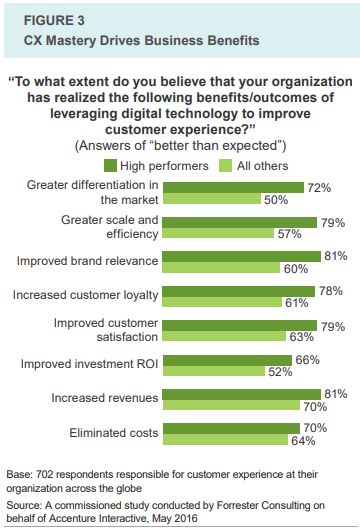Find a competitive advantage by creating an outstanding customer experience.
As barriers to entry are removed and a market matures, suppliers often find themselves ‘one of the pack’ with little product differentiation and eroding profit margins. Buyers also find it hard to justify paying a premium for identical products of the same quality and perceived value. As suppliers are under more pressure to reduce prices, it’s essential to discover new engines of growth.
Innovation plays a critical role. But what happens when product innovation is quickly copied and first mover’s advantage deteriorates in a matter of weeks? How can companies in an oversupplied market remain relevant and valuable to their clients without destroying profitability?
CUSTOMER EXPERIENCE
According to a survey conducted by Walker, “Customer experience will overtake price and product as the key brand differentiator by the year 2020.”
Let that sink in for a moment. In two years’ time, more customers are likely to buy from a company that delivers a better buying interaction - despite the price tag.
So what exactly is customer experience?
It’s every interaction your current and potential customers have with your company. Everything from your marketing, sales, billing and product delivery effort to the installation guides, training, service technicians, and customer support personnel and portals utilized during post-purchase engagements. Every single touchpoint your clients have with your organization are part of the customer experience.
Companies that invest and excel in creating a repeatable positive customer experience gain an incredible competitive advantage over their peers: loyalty, retention and growth.
For companies competing in a saturated market where price wars are common, investing in and creating corporate initiatives to prioritize customer experience may not be the most intuitive option debated in the boardroom. Especially when operating costs are likely the primary topic of concern, particularly if the company is in reactive mode.
But let’s get real for a moment - cost reduction and operational efficiency programs can improve margins only so much before you have to seek value-add growth alternatives from new or existing markets. If you could grow revenue by 4-8% over your competition, isn’t implementing a customer experience initiative worth investigating?
WHERE DO YOU BEGIN?
The above chart was pulled from a research study conducted by Forrester in May 2016, "Expectations vs. Experience: The Good, The Bad & The Opportunity"
We recently published a case study and case study solution that chronicled an online experience of a drilling engineer looking to evaluate tubing options that could be used in a Woodford Shale well. The tubing market is largely commoditized, and there is very little product innovation that warrants a premium price. In the case study, we mapped the Discovery Phase of the buying process which revealed a clearly defined gap between the customer’s expectations and the actual experience.
In the case study solution, we provided several examples of how this particular market could transform the top-of-the-funnel buying experience by leveraging personalization, content marketing and value propositions that are appropriate to the buyer’s mission. We also recommended the use of a customer portal where clients can get product recommendations/suggestions based on where they are drilling and the type of geology they are likely to encounter. (You can download the full case study solution here.)
These types of initiatives begin with evaluating and understanding your client’s expectations and buying motivations, as well as dissecting and aligning your value propositions to address their real concerns. (If you want to know how to develop compelling B2B value propositions, watch this video.)
Beginning with the very first interactions a potential client might have with your product or organization, map the customer buying journey and walk a mile in his/her shoes. We like to use a mind mapping tool called Coggle to create a visual reference of all the touch points a customer has with the organization.
Completing this task with the executive leadership group is essential so all department directors understand how their team contributes to the customer experience. The important thing to remember when doing this exercise is: assume nothing.
Go ‘undercover’ and document actual interactions with your company so you know what to improve and when. For example, call the customer hotline on occasion, ride with a service technician, dispute a bill, surf your company’s website, and read your product literature to gather real data about what a customer experiences when working with your company.
Next comb and analyze existing customer data like purchase history, service reports, call center complaints, billing and payment information, marketing data and any other information that will give you the most detail about your top 20 clients. The key to customer experience is to make each engagement authentic, personalized and simple for the customer to get what they need. You want them to feel as if every interaction is 1:1 and important. In order to do this, you must know your customers intimately.
Identify the gaps between what the customer expects and what your organization is currently delivering, and create a plan to address as many of them as reasonably possible. Each department should aim to support a new mission and every employee should rally behind the question, “what would the customer like?” Unlike the story of the Zappos customer service rep who stayed on the phone for hours with a client, you do need to ensure company behavior is aligned to the goal at a reasonable rate of return on the resource investment. Make sure you assign KPIs and deadlines to the initiatives.
QUICK WINS TO CONSIDER
If you are working in a highly competitive B2B market where price has become your weapon of choice for winning on the battlefield, you may want to consider the following areas to begin transforming the customer experience.
- Account-based Marketing
- Customer Portals for Managing Service Requests, Payments & Promotions
- Topic-focused Website Content
- Website Personalization
- eCommerce Solutions or Online Estimators




